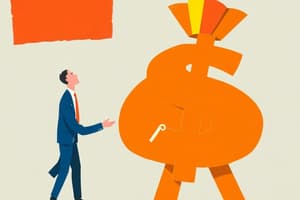Podcast
Questions and Answers
What is the main focus of microeconomics?
What is the main focus of microeconomics?
- Analyzing the behavior of consumers, firms, and markets (correct)
- Understanding climate change effects on economies
- Studying the history of economics
- Exploring global economic policies
Which concept in microeconomics examines the costs of production at the firm level?
Which concept in microeconomics examines the costs of production at the firm level?
- Consumer behavior
- Demand and supply
- Market structures
- Production and costs (correct)
What do demand and supply help us understand in microeconomics?
What do demand and supply help us understand in microeconomics?
- Market structures
- Types of markets
- Market behavior and price determination (correct)
- Consumer preferences
Why is understanding market failure important in microeconomics?
Why is understanding market failure important in microeconomics?
What is one real-world application of microeconomics mentioned in the text?
What is one real-world application of microeconomics mentioned in the text?
In what way can microeconomics help governments with public policy decisions?
In what way can microeconomics help governments with public policy decisions?
How does microeconomics contribute to understanding labor markets?
How does microeconomics contribute to understanding labor markets?
How can microeconomics be applied to environmental issues?
How can microeconomics be applied to environmental issues?
What aspect of healthcare does microeconomics offer insights into?
What aspect of healthcare does microeconomics offer insights into?
Why is understanding microeconomics considered a valuable tool according to the text?
Why is understanding microeconomics considered a valuable tool according to the text?
Study Notes
Shining a Light on Microeconomics: Lessons from Econ 202
Econ 202 is often referred to as the introductory course to microeconomics, a field that dives deep into how individuals and businesses make decisions in the face of scarcity. This discipline focuses on analyzing the behavior of consumers, firms, and markets, with an aim to understand the economic mechanisms that shape our world.
The Basics of Microeconomics
Essential concepts in microeconomics include the following:
-
Consumer behavior: Microeconomics explores the decisions people make when it comes to spending money, saving, and borrowing. These choices are influenced by preferences, budget constraints, and incentives.
-
Production and costs: At the firm level, microeconomics looks at the costs of production and the way companies make decisions about which goods to produce and how to allocate resources.
-
Demand and supply: These fundamental concepts of microeconomics help us understand the behavior of markets and how prices are determined.
-
Market structures: Microeconomics examines the different types of markets, such as perfect competition, monopolistic competition, oligopoly, and monopoly, and the impact of each on market outcomes and efficiency.
-
Market failure: Inefficiencies can arise in markets due to externalities, public goods, or information asymmetries. Understanding these failures can help inform government policy decisions.
Real-world Applications
Microeconomics touches on an array of real-world issues, such as:
-
Pricing strategies: Understanding consumer behavior can help businesses set prices that maximize profits while also meeting customer demand.
-
Labor markets: Microeconomics helps us understand the forces at play in the labor market, such as wages, employment, and unemployment.
-
Public policy: Governments must make decisions about a wide range of policies, such as taxation, regulation, and subsidies, to improve efficiency and promote welfare. Microeconomics provides a framework for understanding the impacts of these policies.
-
Environmental economics: Microeconomics can be applied to understand the behavior of firms and consumers concerning environmental issues, such as pollution and resource depletion.
-
Healthcare economics: Microeconomics offers insight into healthcare markets and the factors that influence access, quality, and cost.
Conclusion
Microeconomics is a fascinating and practical field that provides a deep understanding of the decisions made by individuals, firms, and organizations. As we continue to navigate the complexities of our economies, microeconomics offers a valuable framework for addressing issues and making informed decisions.
So, whether you're a student, an enthusiast, or a professional, understanding microeconomics is a powerful tool for making sense of the world around you and a critical skill for success in many fields. are not directly related to the content of this article but rather illustrate the use of various search functions to find information, which is not needed for this educational piece.
Studying That Suits You
Use AI to generate personalized quizzes and flashcards to suit your learning preferences.
Description
Learn about essential concepts in microeconomics such as consumer behavior, production and costs, demand and supply, market structures, and market failure. Dive into real-world applications including pricing strategies, labor markets, public policy, environmental economics, and healthcare economics.




